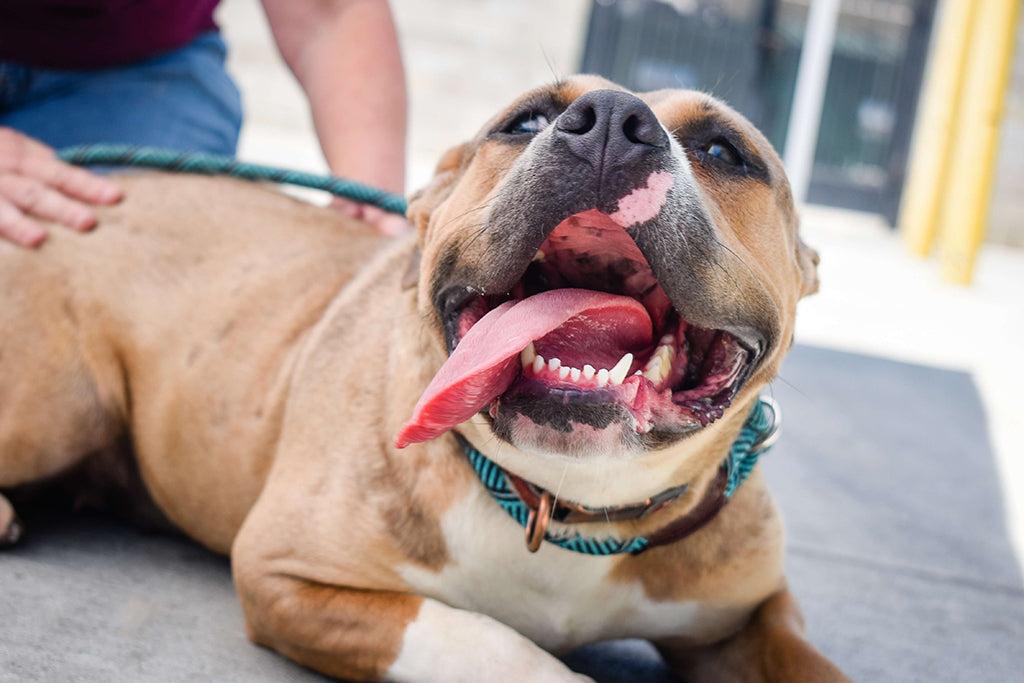In this blog, we learn all about pale gums in dogs! We’ll discover what pale dog gums vs healthy gums are, what it means when a dog’s gums are pale and what you can do about pale gums in dogs! Read on to find out more about white gums in dogs and pale gums in dogs here.
Pale Gums In Dogs

A dog’s oral health is essential for helping ensure their overall health, and the color of their gums can often be a good indicator of where they’re at health-wise. If your dog’s gums are pale in color, this can be a sign of an underlying issue. So, what does it mean when a dog has pale gums? And, what should you do if you spot pale gums in your dog?
What Color Are Dogs Gums Supposed To Be?
Before you can tell if your dog’s gums are looking a little off, you need to know what they should look like. If you’re wondering “what color are dogs gums supposed to be?“, depending on your dog and their breed, a healthy set of dog gums should be pink, ranging from soft pink to bright pink. Your dog’s gums should also be moist.
Some dogs have pigmentation on their gums, causing them to appear black in color. If they have naturally blacker gums, to be sure your dog’s gum health is in tip-top condition, check the lighter spots on their gums for that essential pink shade, the non-pigmented areas, or check the area underneath their tongue. If you press down on the pink gum, it should turn white. When your finger leaves the gum, it should then pop back to pink pretty much immediately.
If you notice that your dog’s gums are looking a little pale or white in color, this is something that needs to be addressed.

What Causes Pale Gums In Dogs?
There are a few conditions that could be causing pale or white gums in your dog.
Blood Loss
If your dog is losing blood from an external or internal injury (or because of some certain disease processes), then there could be an issue of not enough blood being present in the body, therefore it cannot be circulated. Because blood flow to the gums and membranes has decreased, this can cause the pale coloring.
If there is an obvious external bleed, or blood in their vomit or their poop (this may appear black or tar-like in color, once it’s been digested), get them to a vet stat.
Shock
If your dog’s in shock (usually caused by trauma or certain disease processes), this can cause a sudden drop in blood flow throughout the body which can result in tissue damage and organ failure. Pale gums may be a sign of this. Shock is an emergency condition and you should get your pup to your vet immediately if you suspect it.
Anemia
More often than not, pale gums are an indicator of anemia. Anemia occurs when not enough red blood cells are circulating in the bloodstream. A good red blood cell count is essential for carrying the right amount of oxygen needed to all the tissues in the body. If the body becomes deprived of oxygen, this can be life-threatening.
Anemia is usually a symptom of an illness, rather than an illness itself. For example, conditions that cause anemia include kidney disease, parasitic infection, and infectious diseases. Certain medications for some medical issues can cause a decline in a body’s red blood cell count too. In addition, malnutrition or nutritional imbalances can lead to a body becoming anemic.
There is also a condition called hemolysis which causes the destruction of red blood cells, leading to acute anemia. Hemolysis is usually triggered by an auto-immune disease, cancer, babesiosis (caused by blood parasites), or exposure to harsh chemicals or toxins.
Dehydration
If your dog’s gums are looking a little on the pale side, but their gums also feel sticky and/or have lost their shiny appearance, this might be because they’re lacking moisture and need water. Always make sure your dog has easy access to clean, fresh water in a regularly cleaned bowl.

My Dog Has Pale Gums – What Should I Do?
If you’ve noticed your dog has pale gums, you may also clock the following accompanying symptoms:
- Pale mucous membranes of the eyelids
- Pale nose
- Pale tongue
- Bleeding
- Seeming lethargic
- Seeming weak
- Collapsing
First things first, check for the above symptoms and check their body to see if they have any injuries causing them to bleed.
If they have pale gums and any of these other symptoms, you need to get to the vet as a matter of emergency.
If they have pale gums, but otherwise seem their normal self, you need to contact your vet for a scheduled appointment to gain some further insight into the cause and obtain professional advice.
The treatment for pale gums in dogs will entirely depend on the underlying cause. Your vet will examine them, discuss the symptoms with you and most likely request a blood test to check their red blood cell count. If their pale or white gums are being caused by blood loss, they may require a blood transfusion to help replace the lost blood in the body or even surgery to stop the bleed.
Regularly checking your dog’s gums and staying on top of their dental hygiene is of paramount importance as a pet parent, because the condition of their mouth can directly contribute to (and indicate the state of) their overall health.
Sources
Author Stregowski, Jenna “What Do Pale Gums In Dogs Mean?” Spruce Pets, Apr 30. 2021 https://www.thesprucepets.com/what-do-pale-gums-in-dogs-mean-5076194
Author Pendergrass, JoAnna DVM “Pale Gums in Dogs: 10 Reasons It Might Be Happening” Great Pet Care, Nov 23. 2020 https://www.greatpetcare.com/dog-health/pale-gums-in-dogs/#:~:text=Pale%20gums%20in%20dogs%20range,from%20a%20lack%20of%20moisture.
 S
S



